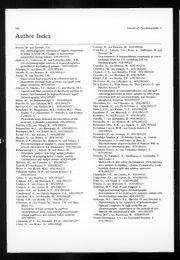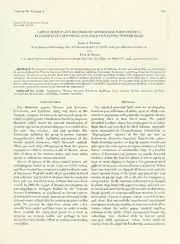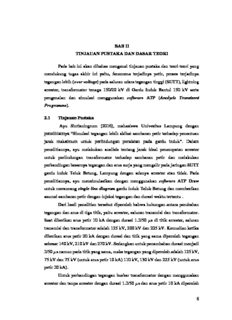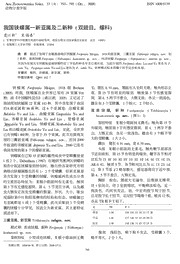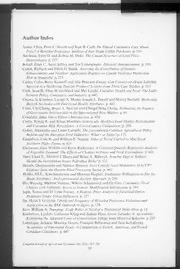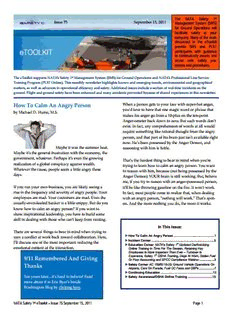
How to Calm an Angry Person - NATA PDF
Preview How to Calm an Angry Person - NATA
The NATA Safety 1st Issue 75 September 15, 2011 Management System (SMS) for Ground Operations will facilitate safety at your company. Many of the tools discussed in the eToolkit provide SMS and PLST participants with guidance to continuously assess and assist with safety pro- cesses and procedures. The eToolkit supports NATA’s Safety 1st Management System (SMS) for Ground Operations and NATA’s Professional Line Service Training Program (PLST Online). This monthly newsletter highlights known and emerging trends, environmental and geographical matters, as well as advances in operational efficiency and safety. Additional issues include a section of real-time incidents on the ground. Flight and ground safety have been enhanced and many accidents prevented because of shared experiences in this newsletter. How To Calm An Angry Person When a person gets in your face with super-hot anger, you'd love to have that one magic word or phrase that by Michael D. Hume, M.S. makes his anger go from a 10-plus on the ten-point Anger-ometer back down to zero. But such words don't exist. In fact, any comprehension of words at all would require something like rational thought from the angry person, and that part of his brain just isn't available right now. He's been possessed by the Anger Demon, and Maybe it was the summer heat. reasoning with him is futile. Maybe it's the general frustration with the economy, the government, whatever. Perhaps it's even the growing That's the hardest thing to bear in mind when you're realization of a global conspiracy against wealth. trying to learn how to calm an angry person. You want Whatever the cause, people seem a little angry these to reason with him, because (not being possessed by the days. Anger Demon) YOUR brain is still working. But, believe me, if you try to reason with an anger-possessed person, If you run your own business, you are likely seeing a it'll be like throwing gasoline on the fire. It won't work. rise in the frequency and severity of angry people. Your In fact, most people come to realize that, when dealing employees are mad. Your customers are mad. Even the with an angry person, "nothing will work." That's spot- usually-even-keeled banker is a little snippy. But do you on. And the more nothing you do, the more it works. know how to calm an angry person? If you want to show inspirational leadership, you have to build some skill in dealing with those who can't keep from ranting. In This Issue: There are several things to bear in mind when trying to turn a conflict at work back toward collaboration. Here, ► How To Calm An Angry Person ................................................1 ► Incident Corner ..........................................................................3 I'll discuss one of the most important: reducing the ► Education Corner NATA’s Safety 1st Updated De/Anti-Icing emotional content of the interaction. Online Training In Time For The Season, Retaining Key Employees Is More Important Than Ever – Turnover Is 9/11 Remembered And Giving Expensive, Safety 1st OSHA Training, Dogs At Work, Stolen Fuel Or Poor Accounting and SPCC Compliance Webinar .................3 Thanks ► Safety Corner AC 150/5210-20: Ground Vehicle Operations On Airports, Cars On Parade, Fuel QC Facts and OBPs ..................7 ► Continuing Education …………………………………..……......12 Ten years later...it’s hard to believe! Read ► Safety Awareness/OSHA Online Training .............................13 more about it in Eric Byer’s Inside Washington Blog by clicking here. NATA Safety 1st eToolkit – Issue 75 September 15, 2011 Page 1 TThhee NNAATTAA SSaaffeettyy 11sstt MMaannaaggeemmeenntt SSyysstteemm ((SSMMSS)) ffoorr GGrroouunndd OOppeerraattiioonnss wwiillll ffaacciilliittaattee ssaaffeettyy aatt yyoouurr ccoommppaannyy.. MMaannyy ooff tthhee ttoooollss ddiissccuusssseedd iinn tthhee eeTToooollkkiitt pprroovviiddee SSMMSS aanndd PPLLSSTT ppaarrttiicciippaannttss wwiitthh gguuiiddaannccee ttoo ccoonnttiinnuuoouussllyy aasssseessss aanndd aassssiisstt wwiitthh ssaaffeettyy pprroo-- cceesssseess aanndd pprroocceedduurreess.. The first step in calming the angry person is to reduce the emotional content. Just listen. If you have great people skills, you can try a little empathy... but most of the words that come out of your mouth will risk re-agitating the angry person. The idea is to let some time pass, let some of the angry person's adrenaline ventilate, and wait for things to quiet down. Studies have shown that a person doesn't have the energy to maintain the highest levels of yelling and screaming for more than about ninety seconds. It might seem like 90 minutes, but really, it passes fairly quickly. When they finally calm down, try some empathetic words in a soothing tone, and you are likely to find you're better able to communicate. There are more techniques to master in order to calm the anger-possessed - watch for future articles. Meanwhile, if you come across an angry person and can't think of anything else to do, just be patient, listen, and try to show some empathy. Reduce the emotional content, and the rational part of the interaction will have a chance to emerge. Michael Hume - About the Author: Michael Hume is a speaker, writer, and consultant specializing in helping people maximize their potential and enjoy inspiring lives. As part of his inspirational leadership mission, he coaches executives and leaders in growing their personal sense of well-being through wealth creation and management, along with personal vitality. Those with an entrepreneurial spirit who want to make money "one less thing to worry about" can learn more about working with Michael at http://www.caym.tv/18812. Anyone wanting to jump-start their vitality can browse through the best (and most travel-friendly) nutraceuticals on the market at http://shop.enivausa.com/239824. Michael and his wife, Kathryn, divide their time between homes in California and Colorado. They are very proud of their offspring, who grew up to include a homemaker, a rock star, a service talent, and a television expert. Two grandchildren also warm their hearts! Visit Michael's web site at http://michaelhume.net. NATA Safety 1st eToolkit – Issue 75 September 15, 2011 Page 2 TThhee NNAATTAA SSaaffeettyy 11sstt MMaannaaggeemmeenntt SSyysstteemm ((SSMMSS)) ffoorr GGrroouunndd OOppeerraattiioonnss wwiillll ffaacciilliittaattee ssaaffeettyy aatt yyoouurr ccoommppaannyy.. MMaannyy ooff tthhee ttoooollss ddiissccuusssseedd iinn tthhee eeTToooollkkiitt pprroovviiddee SSMMSS aanndd PPLLSSTT ppaarrttiicciippaannttss wwiitthh gguuiiddaannccee ttoo ccoonnttiinnuuoouussllyy aasssseessss aanndd aassssiisstt wwiitthh ssaaffeettyy pprroo-- cceesssseess aanndd pprroocceedduurreess.. INCIDENT CORNER A Canadair CRJ-700 aircraft on taxi to ramp, baggage cart struck the left wing, no injuries, passengers deplaned and damage unknown. EDUCATION CORNER NATA’s Safety 1st Updates De/Anti-Icing Training In Time For The Season As we start into the deicing season, as hard as it is to imagine given the heat of this summer, NATA's Safety 1st department is pleased to announce the release of its updated De/Anti-icing training module. Winter weather training programs like NATA's Safety 1st De/Anti-Icing module are designed to familiarize line service specialists with the responsibilities of their job and give an overview of the skills necessary for safe aircraft departures. The De/Anti-icing training module was first released in 2010 and viewed by nearly 120 students in preparation for the icy season. What's New, Updated and Expanded? • Supplementary documentation on different types of contamination • Holdover table (HOT) graphics • 2011-2012 HOTs are now linked in the training • Communication section between crews and deicing technician • Anti-icing and deicing sections to clarify sequence of procedures • Quizzes and exams Click here to view a demo video. Visit www.nata.aero/plst to learn more about this and other training modules. NATA Safety 1st eToolkit – Issue 75 September 15, 2011 Page 3 TThhee NNAATTAA SSaaffeettyy 11sstt MMaannaaggeemmeenntt SSyysstteemm ((SSMMSS)) ffoorr GGrroouunndd OOppeerraattiioonnss wwiillll ffaacciilliittaattee ssaaffeettyy aatt yyoouurr ccoommppaannyy.. MMaannyy ooff tthhee ttoooollss ddiissccuusssseedd iinn tthhee eeTToooollkkiitt pprroovviiddee SSMMSS aanndd PPLLSSTT ppaarrttiicciippaannttss wwiitthh gguuiiddaannccee ttoo ccoonnttiinnuuoouussllyy aasssseessss aanndd aassssiisstt wwiitthh ssaaffeettyy pprroo-- cceesssseess aanndd pprroocceedduurreess.. Retaining Key Employees Is More Important Than Ever – Turnover Is Expensive Very few companies understand how much money they lose by failing to retain key employees. For example; replacing an HR Manager in the automotive industry can cost $133,803, a machine shop that loses a skilled, salaried machinist can lose $102,796 from its bottom line and the loss of a Store Manager can cost a fast-food chain $21,931. Take the time to calculate the cost of losing one of your company’s valuable employees. According to consulting firm Kepner-Tregoe, Inc. and the Saratoga Institute, here’s a formula to use: Here are the steps: • Select a job function with a lot of turnover. Calculate the full cost of that function by 1. Annual wage _________ entering the average wage for that position 2. Gross-up for benefits x 1.30 on Line 1 and then multiply it by 130% 3. Total wage _________ to include benefits costs. 4. Turnover cost x 0.25 5. Cost per employee _________ • Next, multiply the total wage by 25% turnover. This cost per employee may then be multiplied by 6. Ex-employee(s) x # ______ the number of ex-employees on Line 6 to 7. Total turnover cost _________ arrive at the total cost of turnover in this position. Real Number Example: Annual wage $30,000 Gross-up for benefits x 1.30 Turnover of employees can be costly as seen by our real number Total wage $39,000 example. It’s important to Turnover cost x 0.25 remember - retaining employees is Cost per employee 48,750 a savings to your company! Ex-employee(s) x # 5 Total turnover cost $243,750 NATA Safety 1st eToolkit – Issue 75 September 15, 2011 Page 4 TThhee NNAATTAA SSaaffeettyy 11sstt MMaannaaggeemmeenntt SSyysstteemm ((SSMMSS)) ffoorr GGrroouunndd OOppeerraattiioonnss wwiillll ffaacciilliittaattee ssaaffeettyy aatt yyoouurr ccoommppaannyy.. MMaannyy ooff tthhee ttoooollss ddiissccuusssseedd iinn tthhee eeTToooollkkiitt pprroovviiddee SSMMSS aanndd PPLLSSTT ppaarrttiicciippaannttss wwiitthh gguuiiddaannccee ttoo ccoonnttiinnuuoouussllyy aasssseessss aanndd aassssiisstt wwiitthh ssaaffeettyy pprroo-- cceesssseess aanndd pprroocceedduurreess.. Safety 1st – New Safety Awareness/OSHA Training Maintaining a safe operation and work environment is more than good business; it keeps your operation safe, secure and fully compliant with the Occupational Safety and Health Administration. NATA's Safety 1st has many aviation safety awareness training modules from which to choose. Each company can build numerous curriculums to fit the needs of their organization. View our new demo video to find out more about this potentially lifesaving training. Click here to learn more or to access training. Dogs At Work Maverick visits the NATA offices occasionally and poses next to NATA’s PLST Online training. We thought it’d be fun to start highlighting dogs at work. If you have a story to share, please email a picture to safety1st@nata.aero with a short write-up for our readers. NATA Safety 1st eToolkit – Issue 75 September 15, 2011 Page 5 TThhee NNAATTAA SSaaffeettyy 11sstt MMaannaaggeemmeenntt SSyysstteemm ((SSMMSS)) ffoorr GGrroouunndd OOppeerraattiioonnss wwiillll ffaacciilliittaattee ssaaffeettyy aatt yyoouurr ccoommppaannyy.. MMaannyy ooff tthhee ttoooollss ddiissccuusssseedd iinn tthhee eeTToooollkkiitt pprroovviiddee SSMMSS aanndd PPLLSSTT ppaarrttiicciippaannttss wwiitthh gguuiiddaannccee ttoo ccoonnttiinnuuoouussllyy aasssseessss aanndd aassssiisstt wwiitthh ssaaffeettyy pprroo-- cceesssseess aanndd pprroocceedduurreess.. Stolen Fuel Or Poor Accounting? "Waterville airport missing fuel -With 2,000 gallons missing, police suspect theft or poor accounting -Police are investigating the possible theft of about 2,000 gallons of aircraft fuel from the city-owned Robert LaFleur Municipal Airport. City Engineer Greg Brown, who manages the airport, reported to police that fuel was missing from an airport fuel tank in late June." Take a few minutes today and ensure that access to your fuel storage facility is secured and that you are properly recording and tracking the movement of fuel through your facility. SPCC Compliance Webinar – September 19th The final date for compliance with the EPA’s Spill Prevention, Control and Countermeasures (SPCC) rules is set for November 10 of this year. Is your facility ready? The SPCC rules require facilities with aboveground storage of oils (including aviation fuels) in excess of 1,320 gallons to have and implement an SPCC plan. If a facility stores more than 10,000 gallons, their SPCC Plan must be certified by a Professional Engineer. The rules governing SPCC underwent a major re-write in 2002 and amendments in 2006 and 2009. Now compliance with all three rule changes is just around the corner. The SPCC Compliance Webinar will give your facility the latest information on compliance with the complex rules and will include featured speaker, George Gamble, founder of 2G Environmental. 2G Environmental was founded in 2003 and has extensive experience in Aviation specific SPCC plans and other areas of environmental compliance. Webinar attendee’s will receive answers to the following vital questions; What are the SPCC rules and how do they apply to aviation facilities? What does the November 10th deadline mean? Is my facility included? What new components must be included in SPCC plans by Nov. 10? What are the possible fines for non-compliance with the SPCC rules? In addition to answering vital questions, attendee’s will have a chance to ask their own questions to one of the aviation industries leading experts on SPCC compliance. Don’t miss this opportunity to prepare for the upcoming SPCC compliance deadline! NATA Safety 1st eToolkit – Issue 75 September 15, 2011 Page 6 TThhee NNAATTAA SSaaffeettyy 11sstt MMaannaaggeemmeenntt SSyysstteemm ((SSMMSS)) ffoorr GGrroouunndd OOppeerraattiioonnss wwiillll ffaacciilliittaattee ssaaffeettyy aatt yyoouurr ccoommppaannyy.. MMaannyy ooff tthhee ttoooollss ddiissccuusssseedd iinn tthhee eeTToooollkkiitt pprroovviiddee SSMMSS aanndd PPLLSSTT ppaarrttiicciippaannttss wwiitthh gguuiiddaannccee ttoo ccoonnttiinnuuoouussllyy aasssseessss aanndd aassssiisstt wwiitthh ssaaffeettyy pprroo-- cceesssseess aanndd pprroocceedduurreess.. SAFETY CORNER AC 150/5210-20: Ground Vehicle Operations On Airports This is a continuation from our August 17th issue about operating vehicles on the airport taking applicable sections from the AC for review. Challenge your line personnel to know and understand safe communication practices while on the airport. 4.5. Phonetic Aviation Alphabet. Because some letters have similar sounds, like B and P, the international aviation industry uses the following words to reduce confusion. For example; Taxiway B would be referred to as Taxiway Bravo on the radio. A ALFA N NOVEMBER B BRAVO O OSCAR C CHARLIE P PAPA D DELTA Q QUEBEC E ECHO R ROMEO F FOX-TROT S SIERRA G GOLF T TANGO H HOTEL U UNIFORM I INDIA V VICTOR J JULIET W WHISKEY K KILO X X-RAY L LIMA Y YANKEE M MIKE Z ZULU 4.6. ATCT Light Gun Signals. Air traffic controllers have a backup system for communicating with aircraft or ground vehicles if their radios stop working. The controller has a light gun in the tower that can send out different colored lights to tell the pilot or driver what to do. If a vehicle operator experiences a radio failure on a runway or taxiway, the operator should vacate the runway as quickly and safely as possible and contact the ATCT by other means, such as a cellular telephone, and advise the ATCT of the situation. If this is not practical, then the driver, after vacating the runway, should turn the vehicle toward the tower and start flashing the vehicle headlights and wait for the controller to signal with the light gun. Light gun signals, and their meaning, are as follows: Steady Green OK to cross runway or taxiway. Steady Red STOP! Flashing Red Move off the runway or taxiway. Flashing White Go back to where you started. Alternating Red and Green Use extreme caution. NATA Safety 1st eToolkit – Issue 75 September 15, 2011 Page 7 TThhee NNAATTAA SSaaffeettyy 11sstt MMaannaaggeemmeenntt SSyysstteemm ((SSMMSS)) ffoorr GGrroouunndd OOppeerraattiioonnss wwiillll ffaacciilliittaattee ssaaffeettyy aatt yyoouurr ccoommppaannyy.. MMaannyy ooff tthhee ttoooollss ddiissccuusssseedd iinn tthhee eeTToooollkkiitt pprroovviiddee SSMMSS aanndd PPLLSSTT ppaarrttiicciippaannttss wwiitthh gguuiiddaannccee ttoo ccoonnttiinnuuoouussllyy aasssseessss aanndd aassssiisstt wwiitthh ssaaffeettyy pprroo-- cceesssseess aanndd pprroocceedduurreess.. 4.7. Safety. The FAA defines runway incursion as “Any occurrence at an airport involving the incorrect presence of an aircraft, vehicle or person on the protected area of a surface designated for the landing and takeoff of aircraft.” Runway incursions are primarily caused by error in one or more of the following areas: Pilot/ground vehicle/controller communications Airport familiarity Loss of situational awarenessAn example of an incursion is a vehicle at an airport with an operating ATCT straying onto a runway in front of an aircraft causing the pilot to take an action to avoid a collision. When driving on the airfield, vehicle operators need to always be aware of their location and the meaning of all pavement markings, lights, and signs. When on the aprons and taxiways, stay away and steer clear of aircraft. Aircraft always have the right-of-way. NOTE: Any individual involved in a runway incursion should receive remedial airfield driver’s training given by the (AIRPORT OPERATOR). This is an appropriate place to describe an individual airport’s runway and taxiway identification system. In addition to the system description, the FAA recommends that the airport operator provide a runway (RY) and taxiway (TWY) diagram, especially if the airport’s identification system varies from the norm or is otherwise complicated. To obtain a copy of AC 150/5210-20 on Ground Vehicle Operations On Airports click here. NATA Safety 1st eToolkit – Issue 75 September 15, 2011 Page 8 TThhee NNAATTAA SSaaffeettyy 11sstt MMaannaaggeemmeenntt SSyysstteemm ((SSMMSS)) ffoorr GGrroouunndd OOppeerraattiioonnss wwiillll ffaacciilliittaattee ssaaffeettyy aatt yyoouurr ccoommppaannyy.. MMaannyy ooff tthhee ttoooollss ddiissccuusssseedd iinn tthhee eeTToooollkkiitt pprroovviiddee SSMMSS aanndd PPLLSSTT ppaarrttiicciippaannttss wwiitthh gguuiiddaannccee ttoo ccoonnttiinnuuoouussllyy aasssseessss aanndd aassssiisstt wwiitthh ssaaffeettyy pprroo-- cceesssseess aanndd pprroocceedduurreess.. Cars on Parade Cars on parade are sponsored by the local Chamber for business and civic organization members. This is the entry for the airport and was on display at the Concord Mills Mall, one of North Carolina's # 1 tourist attractions. It will be displayed at the Charlotte Motor Speedway the week of the October races. NOTE: NATA’s Safety 1st sticker! Fuel QC Facts Aviation fuel quality control is the process of ensuring that only clean, dry, on specification fuel is pumped into aircraft. Beyond that mission, however, quality control also focuses on ensuring that fuel is handled safely, and that means focusing on fire safety. One of the key components to fire safety is understanding the various physical properties of the different types of aviation fuels. Two of those properties are flashpoint and rate of flame spread. Flashpoint - The lowest temperature at which a liquid gives off sufficient vapors to create an ignitable mixture of fuel and air: Jet A Flash Point= +100° F 100LL Avgas Flashpoint = -50° F Rate of Flame Spread - The speed at which flames travel across the surface of a body of fuel: Flame spread for an avgas fire is 30 times faster than for a jet a fire Knowing and understanding what these properties mean in fire prevention and extinguishing can be the difference between life and death in an emergency. NATA Safety 1st eToolkit – Issue 75 September 15, 2011 Page 9 TThhee NNAATTAA SSaaffeettyy 11sstt MMaannaaggeemmeenntt SSyysstteemm ((SSMMSS)) ffoorr GGrroouunndd OOppeerraattiioonnss wwiillll ffaacciilliittaattee ssaaffeettyy aatt yyoouurr ccoommppaannyy.. MMaannyy ooff tthhee ttoooollss ddiissccuusssseedd iinn tthhee eeTToooollkkiitt pprroovviiddee SSMMSS aanndd PPLLSSTT ppaarrttiicciippaannttss wwiitthh gguuiiddaannccee ttoo ccoonnttiinnuuoouussllyy aasssseessss aanndd aassssiisstt wwiitthh ssaaffeettyy pprroo-- cceesssseess aanndd pprroocceedduurreess.. Operational Best Practices (OBP) – We Have A Question For You NATA's Safety & Security Committee continues to roll out best practices to assist FBOs with safety procedures and policies. We’d like to ask what other best practice guidance you need? Please see the list below of OBPs developed to date. We are looking to create additional OBPs but need your input by email safety1st@nata.aero with ideas; thanks in advance for your feedback. The operational best practices (OBP) were developed by industry experts on NATA's committee who have many years of aviation experience at an FBO. The recommendations contained in the OBPs provide best practice guidance so that FBOs may develop manuals and procedures to best deal with their operation and associated risks. NATA’s OBPs provide an introduction that guides you through the process of tailoring the OBPs to your operation along with a record of revisions and assistance on the following best practices; OBP-1 Safety Management System OBP-2 Safety Committee OBP-3 Vehicle Seats OBP-4 50/10 Circle of Safety OBP-5 Propeller Handling OBP-6 Chock Aircraft in Hangars OBP-7 Safety Cones OBP-8 Securing Aircraft OBP-9 GA Aircraft Towing OBP-9A Tow Tracking Log OBP-9B Towing Inspection Log OBP-9C Tow bar Head Usage Instructions & Checklist OBP-9D Whistles for Wing Walkers OBP-10 Foreign Object Damage (FOD) Prevention OBP-11 Cell Phone / Media Device Use In Working Areas OBP-12 Motorized/Mobile Equipment Check List OBP-13 Adverse Weather – Monitoring NATA Safety 1st eToolkit – Issue 75 September 15, 2011 Page 10
Description:The list of books you might like

Credence

As Good as Dead

The Mountain Is You

Shatter Me Complete Collection (Shatter Me; Destroy Me; Unravel Me; Fracture Me; Ignite Me)
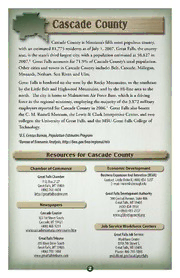
Demographic & economic information for Cascade County

DTIC ADA443237: Interdisciplinary Research Project to Explore the Potential for Developing Non-Lethal Weapons Based on Radiofrequency/Microwave Bioeffects

DTIC ADA456128: Evaluation of Human-Robot Interaction Awareness in Search and Rescue
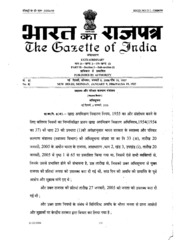
Extraordinary Gazette of India, 2006, No. 516
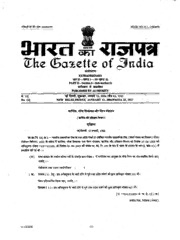
Extraordinary Gazette of India, 2006, No. 528

Sanskritik Binimay Aru Sanhati

aquatic weeds in the sudan

BIO-SECURITY COORDINATION
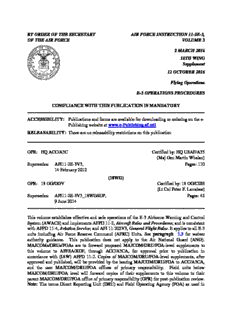
BY ORDER OF THE SECRETARY OF THE AIR FORCE AIR FORCE INSTRUCTION 11-2E-3 ...

Hypoxische Gefährdung des Fetus sub partu: Klinik und neue Überwachungsverfahren

Características zoogeográficas de la ictiofauna litoral de las islas de Cabo Verde y comparación con los archipiélagos macaronésicos

Greek Government Gazette: Part 3, 2006 no. 397
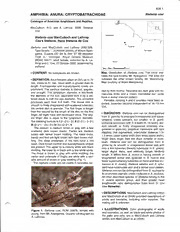
Stefania coxi

Precious Memories by George C. Lambert
